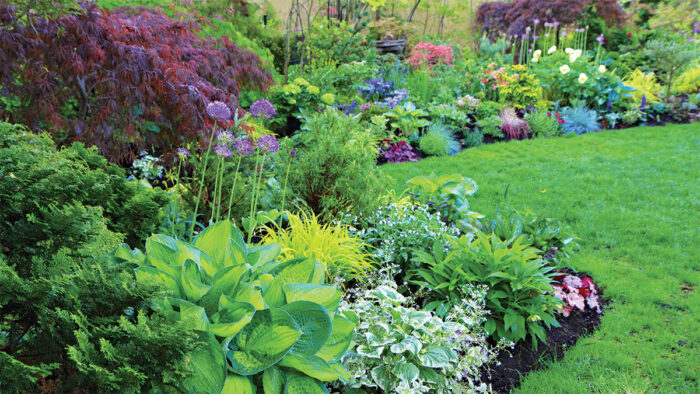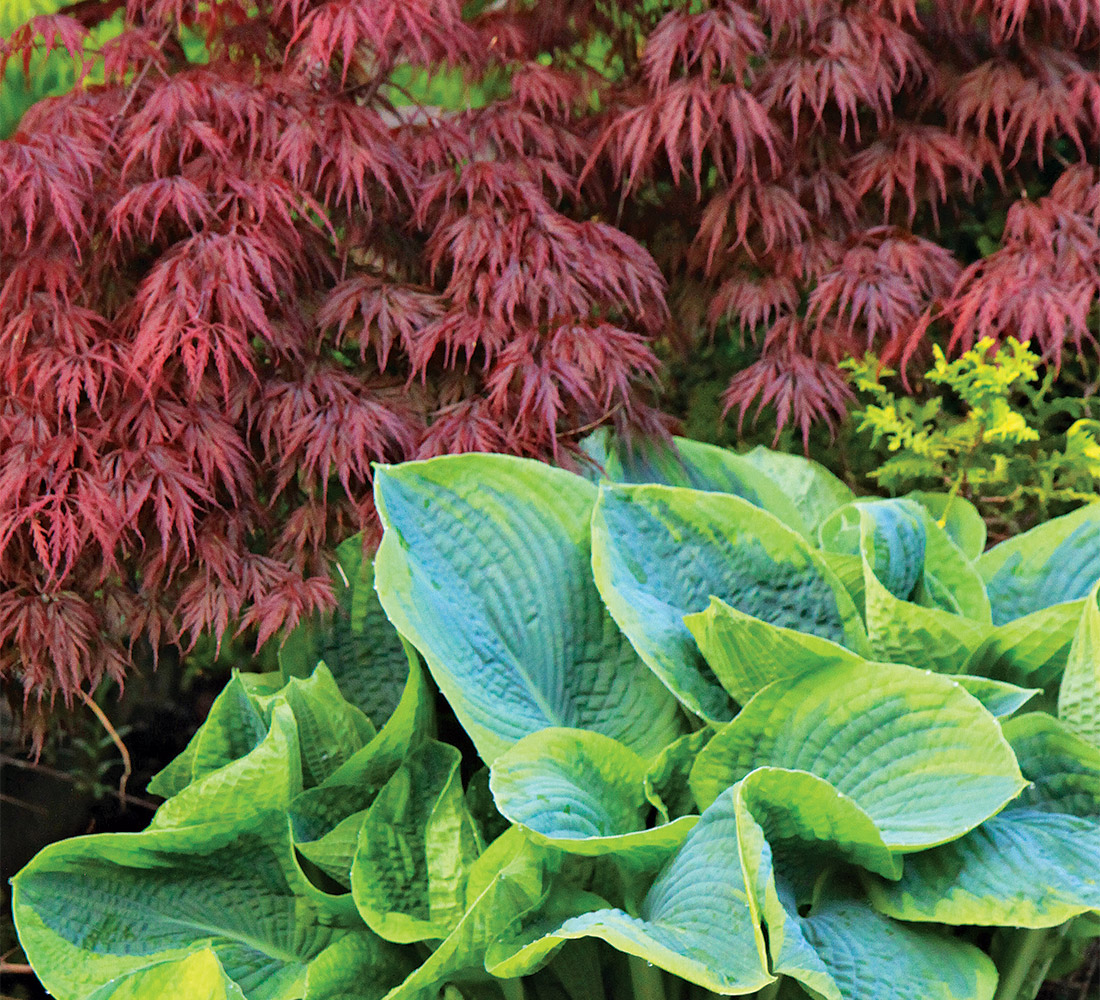
After my husband and I moved into our home in 2004, I waited four years before starting a garden. The idea of creating a new design from scratch was daunting. What would I do with all of this space and all of this shade? I spent hours walking the site, watching how the light changed throughout the day, and I studied garden magazines and plant catalogs to figure out what could thrive in dappled shade under a canopy of mature oaks. When it was finally time to start planting, my approach was very intuitive. Building on a palette of a few favorite plants, I became part of an evolving process. The plants teach me what they can do, and I try my best to help them reach their full potential. I have grown to love the shade, and I can’t imagine what my garden would be like without it. The key has been to find a palette of shade-loving plants with a long season of color and interest.
Plant what you love, but be sure your favorites are sited right
Japanese maples (cultivars of Acer palmatum, A. japonicum, and A. shirasawanum, Zones 5–8) have always caught my eye. I love the array of colors they provide from spring through fall, as well as the gorgeous branch structures they reveal in winter. So, not knowing much about gardening, I started with a few of these small trees, which are adapted to grow in the bright, filtered light of the forest understory.

Imagine the scene when my daughter and I brought home our first trees. We would choose a spot and take turns standing there, arms up, pretending to be the tree in question, while the other stood back to guess how the end result might look. This may not be the most efficient way to site trees, but we had a lot of fun doing it.

We now have quite a few Japanese maples; I stopped counting at 250. These trees serve as an always interesting middle layer between the lower-growing shrubs and herbaceous plants in our garden, and the magnificent oak trees that dominate the landscape. The red- and chartreuse-leaved varieties weave consistent color throughout the beds, drawing one’s attention like bold brushstrokes in a painting from the moment the foliage unfurls in spring until the last of the colorful leaves drop in autumn.
Japanese forest grasses (Hakonechloa macra and cvs., Zones 5–9) are also staples in my shady garden because of their great texture and steadfast performance in partial shade. Once I saw what these plants could do, I wondered how anyone with shade could live without them. They have a cascading habit that perfectly complements large-leaved shade perennials and feathery ferns. Planted in masses, they add soft, flowing movement in spots where most other grasses can’t be used. You will find them throughout most of our garden, softening the edges of beds, gracefully filling in between trees and shrubs, and trailing around the sides of our water features. Like the Japanese maples, they act as unifying elements, adding splashes of color and tying distant beds to each other.
Diversify the plant portfolio to keep things colorful all season
My husband and I are accountants, so our gardening season begins when the Canadian tax season ends. After April 30, the garden offers a welcome creative outlet, a place to experiment with color and to try new ideas with no computers or numbers in sight. In summer, I spend every possible minute in the garden, adding plants, moving them until they are happy, and cheering them on as they create a living artwork.

Adding annual and tropical plants to a framework of hardy trees and perennials is one of my favorite ways to get creative and add pops of color in summer, when I’m in the garden the most. I intentionally leave openings for tender annuals that boast impressive floral displays or colorful foliage. These add a lot of interest, even late in the season. I often start dahlias (Dahlia spp. and cvs., Zones 8–12) in pots, allowing them to size up in a sunnier, out-of-the-way spot before moving them into the main garden. When perennials fade or spring bulbs go dormant in a prime location, I can tuck in some big, gorgeous dahlias to create new focal points.
Coleus (Plectranthus scutellarioides cvs., Zones 11–12) grow well in the shade and are perfect for providing a splash of color in a high-visibility area. For maximum impact, I often leave them in their pots, sometimes propping them up to give them extra height so they can be seen among taller plants.
I also tuck in some dramatic tropical plants, like bananas (Musa and Ensete cvs., Zones 8–10) and elephant’s ears (Colocasia, Alocasia, and Xanthosoma cvs., Zones 9–11) to lend bold texture among finer-leaved perennials and woodies. Frequently I leave them in their big pots, though sometimes I plant them in the ground. The payoff comes with the over-the-top interest they contribute late in the season, after many perennials fade.
Stay flexible, especially in the shade


One of the biggest things my garden has taught me is that shade from tall trees is not constant or uniform. It is fun to see light breaking through in different places throughout the day, like a spotlight showcasing plants and garden vignettes. Sometimes shade can change very suddenly, as it did when a large oak tree blew down in a storm a few years back. Living with the opening it left, I realized that its passing presented new opportunities. The tree’s tall stump now elegantly supports a ‘Miranda’ climbing hydrangea, and the surrounding plants have flourished in the additional light they receive. Gardeners, especially shade gardeners, are often reminded that we are not in charge of what nature chooses to do.
Colorful, shade-loving plants are sometimes hard to find, and this has also helped to teach me flexibility. Because a few key nurseries in our area closed this year, my favorite coleus and other annuals I count on buying each spring were not available. I substituted in some Persian shields (Strobilanthes dyerianus, Zones 9–11) that I had on hand, and they added a totally new and unexpected look.
If you are holding off on starting a garden because you aren’t sure where to start, I suggest taking an intuitive approach. Find plants you love, and let them be your guide. Ask the plants where they would like to go, and do your best to make them happy. You will be surprised and delighted by how they work together to create harmonies you never could have imagined.
Mary Gore is an accountant who gardens in The Beaches neighborhood of Toronto.
Photos, except where noted: Paul Zammit
Fine Gardening Recommended Products

ARS Telescoping Long Reach Pruner
Fine Gardening receives a commission for items purchased through links on this site, including Amazon Associates and other affiliate advertising programs.

Corona® Multi-Purpose Metal Mini Garden Shovel
Fine Gardening receives a commission for items purchased through links on this site, including Amazon Associates and other affiliate advertising programs.

The Crevice Garden: How to make the perfect home for plants from rocky places
Fine Gardening receives a commission for items purchased through links on this site, including Amazon Associates and other affiliate advertising programs.




















Comments
An absolutely lovely garden! Thanks for sharing. Who knew a shade garden could be so lush and colourful? Inspirational!
FANTASTIC!!
Designing a colorful shade garden is a very creative and authentic post for the new skillful users to get interested in it, but there many other beneficial automotive services available of Proton Motors Pakistan, https://proton.com.pk/. They are so valuable and reliable in giving their awesome vehicles in all over Pakistan.
I came across your post and wanted to thank you for the great garden design ideas! I'm always looking for new ways to create a colorful, living shade garden that has lots of different textures and patterns. Your post is exactly what I needed! :)
https://www.hedgesbc.ca/
I was reading your article on how to design a colorful shade garden. It sounds really cool! I'm actually not much of a gardener myself but after reading this, I think it might be worth taking the time to build one. There are so many different types of plants that can do well in shady conditions and they all have unique foliage colors too. Thanks for posting an awesome article!
https://www.abbotsfordtreeservice.ca/
Thank you so much for writing a very helpful article on how to design a shade garden! I really appreciate the information and all of your hard work.
I have never planted a flower bed before, but after reading this article I feel like it's definitely something that I could tackle. Thank you again!
tree pruning vancouver
Log in or create an account to post a comment.
Sign up Log in